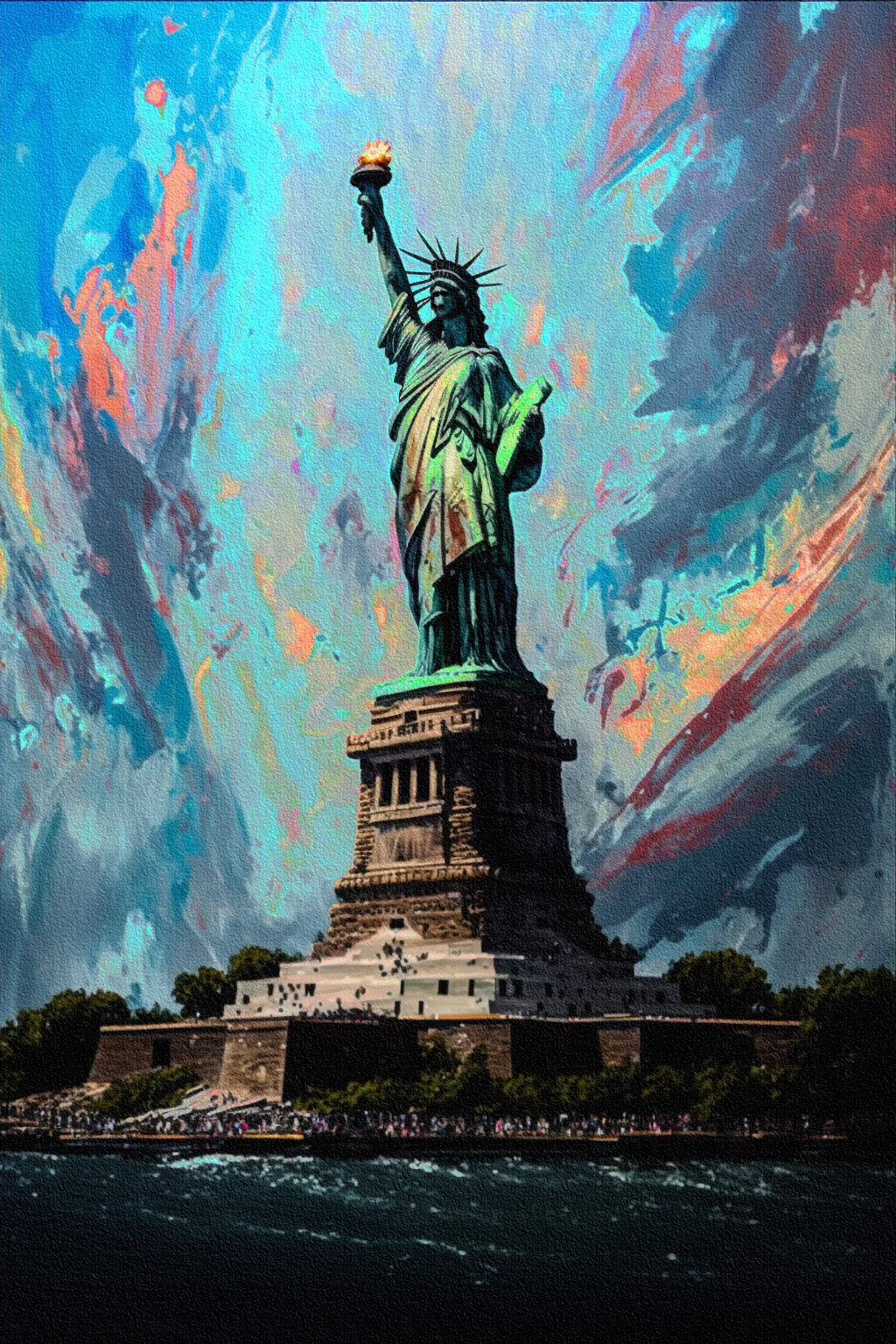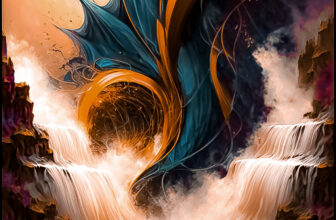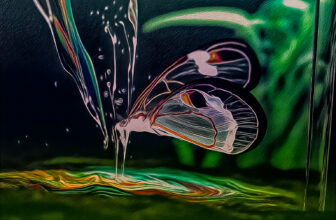
Statue of Liberty Abstract Painting
This artwork portrays the iconic Statue of Liberty standing tall against a vibrant and dynamic sky filled with swirling colors. The painting combines realism and abstraction, with the statue rendered in striking detail while the background bursts with energetic, almost chaotic brushstrokes. The sky features shades of blue, orange, pink, and gray, creating a dramatic atmosphere that evokes both awe and inspiration.
The Statue of Liberty itself is depicted with an artistic flair, retaining its copper-green patina while blending into the modern, vivid palette of the sky. The artist’s use of bold colors and sweeping strokes suggests movement and vitality, almost as though the statue and the sky are connected in an ongoing dialogue. The base of the statue and the surrounding area are painted with subdued tones, which contrast with the vibrant sky and emphasize the statue’s grandeur and resilience.
The choice of colors and the dynamic background may symbolize the ever-changing nature of freedom, hope, and aspiration, which the Statue of Liberty has come to represent. The artwork reflects a fusion of classic symbolism with contemporary artistic expression, making it a powerful reinterpretation of this timeless monument.
History of the Statue of Liberty
Origins and Construction
The Statue of Liberty, officially known as “Liberty Enlightening the World,” was a gift from France to the United States in 1886 to celebrate the centennial of American independence and the enduring friendship between the two nations. The idea was conceived by Édouard René de Laboulaye, a French political thinker and abolitionist, and designed by sculptor Frédéric Auguste Bartholdi.
The statue was constructed using a framework engineered by Gustave Eiffel, who later became famous for designing the Eiffel Tower. It is made of copper sheets that were hammered into shape and assembled over an iron skeleton. The statue stands 305 feet tall from the base to the tip of the torch, making it one of the largest statues in the world at the time of its completion.
The pedestal, designed by American architect Richard Morris Hunt, was funded through public donations and completed in 1886. The statue was assembled on Liberty Island (then called Bedloe’s Island) in New York Harbor and was officially dedicated on October 28, 1886, by President Grover Cleveland.
Symbolism
The Statue of Liberty is a universal symbol of freedom and democracy. The torch she holds aloft represents enlightenment, while the tablet in her left hand bears the date “July 4, 1776,” commemorating American independence. The broken chains at her feet symbolize the abolition of tyranny and oppression.
For millions of immigrants arriving in the United States during the late 19th and early 20th centuries, the statue was a beacon of hope and a welcoming sight as they entered New York Harbor. Its message of liberty and opportunity resonated deeply with those seeking a new life in America.
Cultural Impact
Over the decades, the Statue of Liberty has become a cultural and artistic icon. It has been featured in countless works of art, literature, films, and music, often serving as a symbol of resilience and hope during times of crisis. The statue was designated a National Monument in 1924 and underwent significant restorations in the 20th century, including a major renovation for its centennial in 1986.
Artistic Interpretations
The painting you uploaded appears to be a contemporary interpretation of the Statue of Liberty, blending traditional symbolism with modern artistic techniques. The vibrant colors and dynamic composition reflect the evolving relevance of the statue’s message in today’s world.
The swirling sky may represent the tumultuous nature of history and the ongoing struggles for freedom and equality. By juxtaposing the steadfast figure of the statue with an energetic and unpredictable background, the artist captures the tension between stability and change, a theme that has defined much of modern history.
Connection to Modern Themes
In the context of contemporary issues, this painting may also serve as a reminder of the importance of unity and perseverance in the face of challenges. The Statue of Liberty has long been associated with the ideals of inclusion and opportunity, values that remain deeply relevant today.
Artistic Techniques and Style
This painting employs a mix of techniques to convey its powerful message. The detailed rendering of the statue itself showcases the artist’s technical skill and respect for the original monument. The intricate textures of the statue’s surface, from the folds of the robe to the sharp lines of the crown, demonstrate a meticulous attention to detail.
In contrast, the background is painted with broad, sweeping strokes that create a sense of movement and energy. The use of complementary colors, such as the blue and orange hues, adds depth and visual interest, drawing the viewer’s eye toward the statue while emphasizing the dramatic interplay of light and shadow.
What other people say:
The artist may have used oil or acrylic paints, which are well-suited to creating both fine details and bold, expressive textures. The canvas itself appears to have a textured surface, enhancing the tactile quality of the artwork.
The Statue of Liberty is one of the most iconic symbols of the United States. Standing tall on Liberty Island in New York Harbor, the statue has come to represent freedom, democracy, and hope to millions of people around the world. Its image has been used in countless works of art, from photographs to sculptures, and even in paintings.
The Statue of Liberty painting has been a popular subject among artists for decades. From the early 20th century to the present day, painters have sought to capture the beauty and majesty of the statue in their works. Some have focused on the statue itself, while others have incorporated the surrounding New York skyline or the harbor into their compositions.
One of the most famous Statue of Liberty paintings is undoubtedly the one created by American artist Edward Hopper. Hopper, who was known for his realist style, painted the statue in 1928 as part of a series of paintings that depicted New York City landmarks. In Hopper’s painting, the statue is seen from a distance, its massive form dominating the skyline. The painting captures the statue’s grandeur and its symbolic significance as a beacon of hope and freedom.
Another notable Statue of Liberty painting is the one created by French artist Georges Seurat. Seurat was a pioneer of the pointillist style, in which small dots of color are used to create an image. In Seurat’s painting, which he completed in 1889, the statue is seen from the water, with the New York skyline in the background. The painting is notable for its use of bright, vibrant colors, which give the statue a sense of energy and vitality.
In more recent years, contemporary artists have also created their own interpretations of the Statue of Liberty. One such artist is Peter Max, who is known for his colorful, psychedelic style. Max created a series of paintings featuring the statue in the 1970s, which were inspired by his love of America and its ideals. Max’s paintings are characterized by their bold, bright colors and their sense of joy and optimism.
The Statue of Liberty painting has also been used as a symbol of political and social issues. For example, the American artist Shepard Fairey created a series of paintings featuring the statue in the early 2000s, which were meant to comment on the Iraq War and other issues related to American foreign policy. Fairey’s paintings, which featured the words “Freedom” and “Peace” alongside the statue, were meant to challenge viewers to think critically about the country’s role in the world.
In addition to paintings, the Statue of Liberty has also been featured in other forms of art, such as sculpture and photography. One of the most famous examples of a sculpture featuring the statue is the one created by the French artist Auguste Bartholdi, who designed the statue itself. Bartholdi’s sculpture, which is located in Paris, shows the statue’s torch and arm, which were used as models for the final statue.
Photographers have also captured the beauty of the statue in their works. One of the most famous photographs featuring the statue is the one taken by Lewis Hine in 1908. Hine’s photograph shows a group of immigrant children gazing up at the statue in wonder, a testament to the statue’s enduring significance as a symbol of hope and opportunity.
The Statue of Liberty painting is a testament to the enduring significance of the statue itself. From the realist paintings of Edward Hopper to the pointillist works of Georges Seurat to the contemporary interpretations of Peter Max and Shepard Fairey, artists have sought to capture the statue’s grandeur and its symbolic significance. As the statue continues to inspire artists and viewers alike, it remains a powerful symbol of freedom, democracy, and hope.





